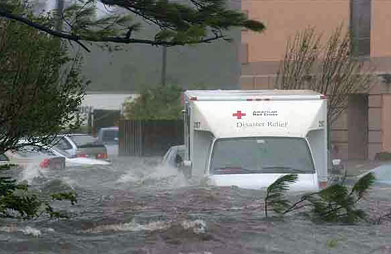Developments in disaster law
 The sad convergence of the first anniversary of Hurricane Katrina and the fifth anniversary of the terrorist attacks of September 11, 2001, has spurred a large amount of legal activity regarding disasters. Two recent developments warrant notice.
The sad convergence of the first anniversary of Hurricane Katrina and the fifth anniversary of the terrorist attacks of September 11, 2001, has spurred a large amount of legal activity regarding disasters. Two recent developments warrant notice.First, the Hurricane Katrina Fraud Task Force has released a report on its first year of activity. According to a news release describing the report:
[A]s of Aug. 17, 2006, the Federal Emergency Management Agency (FEMA) ha[s] received more than 2.5 million applications for disaster assistance relating to Hurricanes Katrina and Rita. While the vast majority of those applicants had legitimate need for the assistance they sought, the Task Force found that numerous people committed fraud in seeking benefits to which they were not entitled, and that "fraud follows the money" -- meaning that criminals tended to exploit any situation with the prospect of personal financial gain. That included, in the first cycles immediately following the hurricane -- charity fraud schemes, emergency assistance schemes such as the false applications for FEMA benefits, and procurement and insurance fraud.
 Among other things, the Task Force recommended best practices for law enforcement after future disasters, such as standardized training in detecting the fraud typically associated with disaster relief programs, public outreach to prevent and deter fraud, protocols for sharing and managing data, and the establishment of Joint Command Centers for coordinated fraud investigation.
Among other things, the Task Force recommended best practices for law enforcement after future disasters, such as standardized training in detecting the fraud typically associated with disaster relief programs, public outreach to prevent and deter fraud, protocols for sharing and managing data, and the establishment of Joint Command Centers for coordinated fraud investigation.Second, the National Emergency Management Association has issued a list of recommendations regarding proposed legislative reforms of the Federal Emergency Management Agency (FEMA):
- FEMA’s name should be maintained and FEMA’s authorities should be restored and strengthened and codified in law
- The FEMA Director must have a direct reporting relationship to the President during times of disaster;
- Preparedness must be linked with response and recovery and belongs with the disaster functions in FEMA
- Emergency management functions must be fenced off, similar to treatment of the Coast Guard and Secret Service in the Homeland Security Act of 2002, to prevent the transfer of functions or resources within the Department of Homeland Security (DHS)
- The Principal Federal Official (PFO) position must be abolished and the Federal Coordinating Officer (FCO) role in the Robert T. Stafford Disaster Relief and Recovery Act should be maintained
- Funding should be restored for vital federal emergency management functions. Funding should also be provided for new tasks identified by Congress in legislation to improve federal, state and local emergency management. Unfunded mandates will further erode the system;
- The Emergency Management Performance Grant (EMPG) should be authorized annually at $470.1 million
- The Emergency Management Assistance Compact (EMAC) should be authorized at $4 million annually
- State and local government must be included by FEMA and DHS in the beginning phase of national strategy, plan, and policy development, rather than simply being asked to bless federally generated documents after the fact













0 Comments:
Post a Comment
<< Home